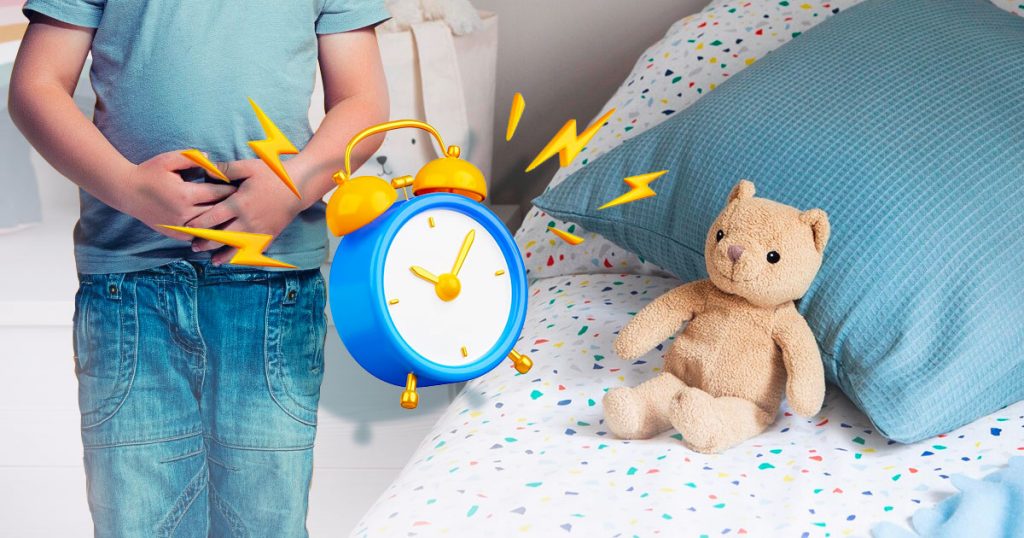As parents, one of our most important roles is guiding our children through various stages of development. Teaching them how to use the toilet is one such task that, while often taken for granted, plays a crucial role in their growth and independence. However, this transition is not always smooth sailing.
Many parents find themselves dealing with bed-wetting episodes that persist night after night. Although common among children, nocturnal enuresis or bedwetting can be frustrating for both parents and kids. Finding an effective solution as early as possible is essential to help your child overcome this issue.
Understanding Nocturnal Enuresis: What is Bedwetting in Children?
Bedwetting, clinically known as nocturnal enuresis, is an issue that affects many children and their families. It refers to involuntary urination during sleep, particularly prevalent in children aged five years or older. This phenomenon is a normal part of a child’s development and is not usually a cause for concern until the child is older and the condition persists.
Despite being a common occurrence, the experience of bedwetting varies among children. Boys are statistically more likely to wet the bed compared to girls. The reasons behind this gender difference are not entirely clear but could be related to developmental variations between boys and girls.
The prevalence of bedwetting tends to decrease with age. While most children naturally outgrow this habit, about 5 to 10 percent of all seven-year-olds continue to wet their beds at night. It’s also worth noting that this percentage gradually decreases as children grow older and gain more control over their bladder function.
It’s important to note that bedwetting is not a sign of laziness or disobedience. Instead, it’s often a natural part of the developmental process, which children can’t control. The persistence of bedwetting could be related to various factors.
The Causes of Nocturnal Enuresis
Bedwetting in children, or nocturnal enuresis, can be attributed to several potential factors. It is often a complex interplay of physical, developmental, and sometimes, psychological elements. Here’s an expanded look at the common causes:
Bladder size
Just like adults, children also vary in the size of their internal organs, including the bladder. Some children have a smaller bladder that can’t hold a large volume of urine. This means they need to urinate more frequently than their peers, and this could lead to bedwetting if the child doesn’t wake up to use the toilet.
Deep sleep
It’s not uncommon for children to be deep sleepers. While this usually leads to well-rested kids, it can also mean that they don’t wake up when their bladder is full. This deep sleep can prevent the signal from the bladder to reach the brain, resulting in bedwetting.
Delayed bladder control
Bladder control is a skill that children develop over time. Some children take longer to develop this control, which means they might not be able to ‘hold on’ during the night. This delay can be due to a variety of reasons, including slower overall physical development or other health issues.
Genetics
Bedwetting tends to run in families. If one or both parents experienced bedwetting as children, their offspring are more likely to experience it too. It suggests that there may be genetic factors involved in the development of this condition.
Medical conditions
Certain medical conditions like urinary tract infections, diabetes, or neurological disorders can lead to bedwetting. These conditions can affect the child’s ability to control their bladder or increase the amount of urine they produce.
In response to these challenges, a practical tool was developed to assist in overcoming this issue – the bedwetting alarm. This device is designed to train children to respond to their body’s signals and wake up when they need to urinate, thereby helping them gain better control over their bladder.
What are Bedwetting Alarms?
Advancements in technology have led to the development of practical solutions like bedwetting alarms. These devices are designed to detect moisture and awaken the child through auditory or tactile signals, thereby training them to wake up and go to the bathroom when they feel the need to urinate.
There are several types of bedwetting alarms available in the market, each with its unique features and benefits:
Wearable Alarms
These devices are typically attached to the child’s underwear or pajamas. They come equipped with a moisture sensor that triggers an alarm as soon as the first signs of wetness are detected. The immediate response helps the child associate the sensation of a full bladder with the need to wake up and use the toilet.
Wireless Alarms
Wireless bedwetting alarms offer more freedom of movement for the child. These systems use a sensor placed in the child’s underwear that communicates wirelessly with an alarm unit located across the room. When the sensor detects wetness, it sends a signal to the alarm unit, which then sounds an alarm to wake the child.
Pad-type Alarms
These alarms involve a moisture-sensitive pad placed under the child while they sleep. If the child begins to urinate, the pad detects the moisture and triggers an alarm. Pad-type alarms can be a good choice for children who might find wearable or wireless alarms uncomfortable.
The Role of Bedwetting Alarms in Addressing Nighttime Wetting
In conclusion, bedwetting alarms serve as a practical, non-invasive solution to help children overcome nocturnal enuresis. While each type of alarm offers unique benefits, the key to their effectiveness lies in consistent use and the child’s active participation.
Remember, it’s important to choose an alarm system that aligns with your child’s comfort and needs, as this increases their willingness to use the device. With patience, persistence, and the right tools, overcoming bedwetting can be a smooth and empowering journey for your child.

